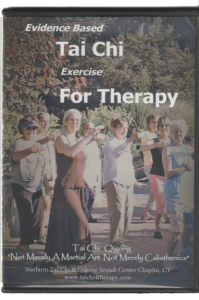Teaching a Tai Chi Fall Prevention Protocol that has its own evidence base*
This instructors guide proposes the final step in a complete tai chi fall prevention protocol. In addition to a “set” of exercises, a duration of time needed for “therapeutic” effect, and a frequency of practice required for results, and a duration of practice, we offer a means to standardize exercise performance. This performance assessment “tool” does not go far from what are generally considered Core Tai Chi Principals.
Tai Chi Mastery is simply the ability to reliably repeat each element of each Tai Chi exercise.

Tai Chi exercise in research has been shown to be widely variable, but there is a movement towards standardizing the activity somewhat. So far that movement has been towards the reduction in the number of exercises included in a tai chi fall prevention protocol, to make learning easier and faster. Quantity of exercises is sacrificed to prefer quality of exercise. Learning tools such as video and pictures in manuals enhance learning to a point, but often do not provide sufficient information for mastery.
Elements and sub-elements of each exercise are identified which can be analyzed by the observer (analysis is calibrated in initial training) and scored, with the scores and compared with a standard score representing success for the activity.
The assessment is the narrative by which training the tai chi fall prevention protocol will most quickly result in mastery. Focusing on the correct performance of the elements of each exercise is the surest way for the student to guide personal practice to mastery and the desirable reliable outcome.
Getting the Assessment Right
There will be disagreement with certain parts of any assessment tool. Different Tai Chi styles and experiences will call for some variation, for example weight distribution. Some experience calls for a 70/30 split, some 100/0, or 50/50. This tai chi fall prevention protocol exercise performance tool can accommodate variations between styles. The key to standardization is that all who use one tool use the one tool in the same manner.
Balance and Functional Outcomes for Older Community-Dwelling Adults Who Practice Tai Chi and Those Who Do Not: A Comparative Study
Deborah Bubela , PT, PhD ; Laddie Sacharko , MA ; Judy Chan , 1 ;
Maegen Brady , PT, DPT Copyright © 2017 Academy of Geriatric Physical Therapy, APTA
DOI: 10.1519/JPT.0000000000000153
[formidable id=”2″ minimize=”1″]